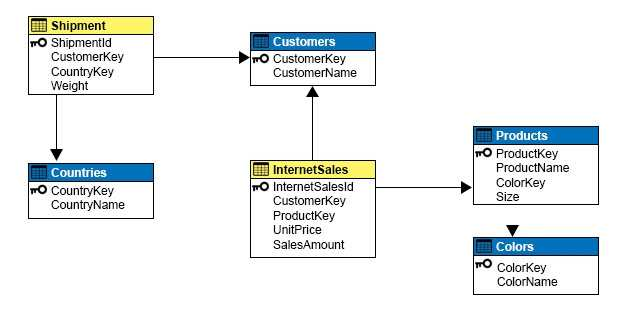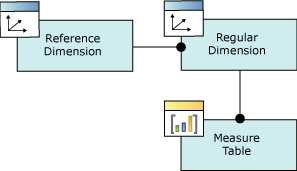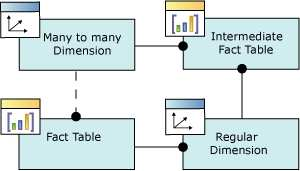Download Developing SQL Data Models.70-768.ActualTests.2018-12-22.19q.vcex
| Vendor: | Microsoft |
| Exam Code: | 70-768 |
| Exam Name: | Developing SQL Data Models |
| Date: | Dec 22, 2018 |
| File Size: | 917 KB |
How to open VCEX files?
Files with VCEX extension can be opened by ProfExam Simulator.
Discount: 20%
Demo Questions
Question 1
Note: This question is part of a series of questions that present the same scenario. Each question in the series contains a unique solution. Determine whether the solution meets the stated goals.
You have a Microsoft SQL Server Analysis Services (SSAS) multidimensional database that stores customer and order data for customers in the United States only. The database contains the following objects:

You must create a KPI named Large Sales Target that uses the Traffic Light indicator to display status. The KPI must contain:

You need to create the KPI.
Solution: You set the value of the Status expression to:

Does the solution meet the goal?
- Yes
- No
Correct answer: A
Question 2
Note: This question is part of a series of questions that present the same scenario. Each question in the series contains a unique solution. Determine whether the solution meets the stated goals.
You have a Microsoft SQL Server Analysis Services (SSAS) multidimensional database that stores customer and order data for customers in the United States only. The database contains the following objects:

You must create a KPI named Large Sales Target that uses the Traffic Light indicator to display status. The KPI must contain:

You need to create the KPI.
Solution: You set the value of the Status expression to:

Does the solution meet the goal?
- Yes
- No
Correct answer: B
Question 3
Note: This question is part of a series of questions that present the same scenario. Each question in the series contains a unique solution. Determine whether the solution meets the stated goals.
You have a Microsoft SQL Server Analysis Services (SSAS) multidimensional database that stores customer and order data for customers in the United States only. The database contains the following objects:

You must create a KPI named Large Sales Target that uses the Traffic Light indicator to display status. The KPI must contain:

You need to create the KPI.
Solution: You set the value of the Status expression to:

Does the solution meet the goal?
- Yes
- No
Correct answer: B
Explanation:
Question 4
Note: This question is part of a series of questions that present the same scenario. Each question in the series contains a unique solution. Determine whether the solution meets the stated goals.
A company has an e-commerce website. When a customer places an order, information about the transaction is inserted into tables in a Microsoft SQL Server relational database named OLTP1. The company has a SQL Server Analysis Services (SSAS) instance that is configured to use Tabular mode. SSAS uses data from OLTP1 to populate a data model.
Sales analysts build reports based on the SSAS model. Reports must be able to access data as soon as it is available in the relational database.
You need to configure and deploy an Analysis Services project to the Analysis Services instance that allows near real-time data source access.
Solution: In the Deployment Option property for the report, you set the Query Mode to InMemory.
Does the solution meet the goal?
- Yes
- No
Correct answer: B
Explanation:
With InMemory the queries can use the cache only. References:https://msdn.microsoft.com/en-us/library/hh230898(v=sql.120).aspx With InMemory the queries can use the cache only.
References:https://msdn.microsoft.com/en-us/library/hh230898(v=sql.120).aspx
Question 5
Note: This question is part of a series of questions that present the same scenario. Each question in the series contains a unique solution. Determine whether the solution meets the stated goals.
A company has an e-commerce website. When a customer places an order, information about the transaction is inserted into tables in a Microsoft SQL Server relational database named OLTP1. The company has a SQL Server Analysis Services (SSAS) instance that is configured to use Tabular mode. SSAS uses data from OLTP1 to populate a data model.
Sales analysts build reports based on the SSAS model. Reports must be able to access data as soon as it is available in the relational database.
You need to configure and deploy an Analysis Services project to the Analysis Services instance that allows near real-time data source access.
Solution: In the Deployment Option property for the report, you set the Query Mode to DirectQuery with InMemory.
Does the solution meet the goal?
- Yes
- No
Correct answer: A
Explanation:
With DirectQuerywithInMemory mode the queries use the relational data source by default, unless otherwise specified in the connection string from the client. References:https://msdn.microsoft.com/en-us/library/hh230898(v=sql.120).aspx With DirectQuerywithInMemory mode the queries use the relational data source by default, unless otherwise specified in the connection string from the client.
References:https://msdn.microsoft.com/en-us/library/hh230898(v=sql.120).aspx
Question 6
Note: This question is part of a series of questions that present the same scenario. Each question in the series contains a unique solution. Determine whether the solution meets the stated goals.
You have an existing multidimensional cube that provides sales analysis. The users can slice by date, product, location, customer, and employee.
The management team plans to evaluate sales employee performance relative to sales targets. You identify the following metrics for employees:
- Ninety percent or greater relative to sales target values is considered on target.
- Between 75 percent and 90 percent is considered slightly off target.
- Below 75 percent is considered off target.
You need to implement the KPI based on the Status expression.
Solution: You design the following solution:

Does the solution meet the goal?
- Yes
- No
Correct answer: B
Question 7
Note: This question is part of a series of questions that present the same scenario. Each question in the series contains a unique solution. Determine whether the solution meets the stated goals.
You have an existing multidimensional cube that provides sales analysis. The users can slice by date, product, location, customer, and employee.
The management team plans to evaluate sales employee performance relative to sales targets. You identify the following metrics for employees:
- Ninety percent or greater relative to sales target values is considered on target.
- Between 75 percent and 90 percent is considered slightly off target.
- Below 75 percent is considered off target.
You need to implement the KPI based on the Status expression.
Solution: You design the following solution:

Does the solution meet the goal?
- Yes
- No
Correct answer: B
Question 8
Note: This question is part of a series of questions that present the same scenario. Each question in the series contains a unique solution. Determine whether the solution meets the stated goals.
You have an existing multidimensional cube that provides sales analysis. The users can slice by date, product, location, customer, and employee.
The management team plans to evaluate sales employee performance relative to sales targets. You identify the following metrics for employees:
- Ninety percent or greater relative to sales target values is considered on target.
- Between 75 percent and 90 percent is considered slightly off target.
- Below 75 percent is considered off target.
You need to implement the KPI based on the Status expression.
Solution: You design the following solution:

Does the solution meet the goal?
- Yes
- No
Correct answer: A
Question 9
Note: This question is part of a series of questions that use the same or similar answer choices. An answer choice may be correct for more than one question in the series. Each question is independent of the other questions in this series. Information and details provided in a question apply only to that question.
You have a Microsoft SQL Server Analysis Services (SSAS) instance that is configured to use multidimensional mode. You create the following cube:

Users need to be able to analyze sales by product and color.
You need to create the dimension.
Which relationship type should you use between the InternetSales table and the new dimension?
- no relationship
- regular
- fact
- referenced
- many-to-many
- data mining
Correct answer: D
Explanation:
A reference dimension relationship between a cube dimension and a measure group exists when the key column for the dimension is joined indirectly to the fact table through a key in another dimension table, as shown in the following illustration. A reference dimension relationship represents the relationship between dimension tables and a fact table in a snowflake schema design. When dimension tables are connected in a snowflake schema, you can define a single dimension using columns from multiple tables, or you can define separate dimensions based on the separate dimension tables and then define a link between them using the reference dimension relationship setting. The following figure shows one fact table named InternetSales, and two dimension tables called Customer and Geography, in a snowflake schema. You can create two dimensions related to the InternetSales measure group: a dimension based on the Customer table, and a dimension based on the Geography table. You can then relate the Geography dimension to the InternetSales measure group using a reference dimension relationship using the Customer dimension. Incorrect Answers:B: A regular dimension relationship between a cube dimension and a measure group exists when the key column for the dimension is joined directly to the fact table. C: Fact dimensions, frequently referred to as degenerate dimensions, are standard dimensions that are constructed from attribute columns in fact tables instead of from attribute columns in dimension tables. E: Many to Many Dimension Relationships.In most dimensions, each fact joins to one and only one dimension member, and a single dimension member can be associated with multiple facts. In relational database terminology, this is referred to as a one-to-many relationship. However, it is frequently useful to join a single fact to multiple dimension members. For example, a bank customer might have multiple accounts (checking, saving, credit card, and investment accounts), and an account can also have joint or multiple owners. The Customer dimension constructed from such relationships would then have multiple members that relate to a single account transaction. References: https://docs.microsoft.com/en-us/sql/analysis-services/multidimensional-models-olap-logical-cube-objects/dimension-relationships A reference dimension relationship between a cube dimension and a measure group exists when the key column for the dimension is joined indirectly to the fact table through a key in another dimension table, as shown in the following illustration.

A reference dimension relationship represents the relationship between dimension tables and a fact table in a snowflake schema design. When dimension tables are connected in a snowflake schema, you can define a single dimension using columns from multiple tables, or you can define separate dimensions based on the separate dimension tables and then define a link between them using the reference dimension relationship setting. The following figure shows one fact table named InternetSales, and two dimension tables called Customer and Geography, in a snowflake schema.

You can create two dimensions related to the InternetSales measure group: a dimension based on the Customer table, and a dimension based on the Geography table. You can then relate the Geography dimension to the InternetSales measure group using a reference dimension relationship using the Customer dimension.
Incorrect Answers:
B: A regular dimension relationship between a cube dimension and a measure group exists when the key column for the dimension is joined directly to the fact table.
C: Fact dimensions, frequently referred to as degenerate dimensions, are standard dimensions that are constructed from attribute columns in fact tables instead of from attribute columns in dimension tables.
E: Many to Many Dimension Relationships.
In most dimensions, each fact joins to one and only one dimension member, and a single dimension member can be associated with multiple facts. In relational database terminology, this is referred to as a one-to-many relationship. However, it is frequently useful to join a single fact to multiple dimension members. For example, a bank customer might have multiple accounts (checking, saving, credit card, and investment accounts), and an account can also have joint or multiple owners. The Customer dimension constructed from such relationships would then have multiple members that relate to a single account transaction.

References: https://docs.microsoft.com/en-us/sql/analysis-services/multidimensional-models-olap-logical-cube-objects/dimension-relationships
Question 10
Note: This question is part of a series of questions that use the same or similar answer choices. An answer choice may be correct for more than one question in the series. Each question is independent of the other questions in this series. Information and details provided in a question apply only to that question.
You have a Microsoft SQL Server Analysis Services (SSAS) instance that is configured to use multidimensional mode. You create the following cube:

Users need to be able to analyze sales by color.
You need to create a dimension that contains all of the colors for products sold by the company.
Which relationship type should you use between the InternetSales table and the new dimension?
- no relationship
- regular
- fact
- referenced
- many-to-many
- data mining
Correct answer: B
Explanation:
A regular dimension relationship between a cube dimension and a measure group exists when the key column for the dimension is joined directly to the fact table. References: https://docs.microsoft.com/en-us/sql/analysis-services/multidimensional-models-olap-logical-cube-objects/dimension-relationships A regular dimension relationship between a cube dimension and a measure group exists when the key column for the dimension is joined directly to the fact table.
References: https://docs.microsoft.com/en-us/sql/analysis-services/multidimensional-models-olap-logical-cube-objects/dimension-relationships
HOW TO OPEN VCE FILES
Use VCE Exam Simulator to open VCE files

HOW TO OPEN VCEX AND EXAM FILES
Use ProfExam Simulator to open VCEX and EXAM files


ProfExam at a 20% markdown
You have the opportunity to purchase ProfExam at a 20% reduced price
Get Now!



